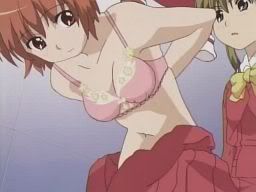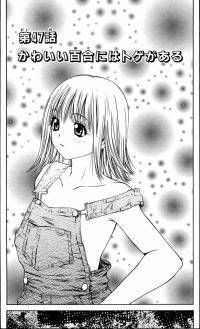Androgyny and Gender Bending – Part III – Boys Become Girls
Last week, I talked about how yaoi and boys’ love comics were not about homosexual relationships but rather a female fantasy of equality in gender roles and the gender bending experience of the female reader to the androgynous “men” in these comics. However, gender bending in manga is not just limited to girls’ comics. There has been a recent trend in comics targeted for boys in which a male protagonist turns into a female and interacts with other girls. For this post, I will focus three such titles currently available in the US: Kashimashi, Gacha Gacha: The Next Revolution, and Pretty Face.
Each one of these stories has a different setup on how the boys become girls. In Kashimashi, young Hazumo is accidentally killed by space aliens. The aliens attempt to resurrect the boy, but are only to bring him back as a female. In Gacha Gacha, a glitch in a virtual reality game causes Akira to become a girl every time he sneezes. And in Pretty Face, a plastic surgeon accidentally turns high school bad ass Rando into a girl after an auto accident leaves him disfigured. While his body is still male, he looks completely female.
Despite these different scenarios, the resulting benefit of this transformation is identical across all three series. Hazumo was rejected by the girl he loved because the girl was unable to see the face of any man. Now that Hazumo himself is also a girl, the two of them start a romantic relationship. The shy Akira was too timid to even talk to his crush. When he turns into a girl, the two of them become best gal pals. And Rando actually turns into he secretly admired. The plastic surgeon modeled Rando’s new face after a photo he kept of her in his pocket. The girl immediately accepts the new Rando as her long-lost twin sister.

Akira (on left in female form) gets close to the girl he likes.
In all three stories, the only way that the male protagonist is able to get near the girl he likes is to become a girl himself. All three boys have difficulty with dealing with the opposite sex. They, like most men, simply fear rejection. Hazumo confessed his feelings to his love, and was crushed when she couldn’t love him back. Akira and Rando are too timid to even try, so they just sit on the sidelines and dream about the relationship they can be having. This is a fear that many teenage otaku know all too well.
But the moment that they become girls, all the pressure and fear are gone as the crushes themselves begin to initiate a relationship. Sure, it starts off as being a platonic friendship between two girls. For Akira and Rando, their partners are not even aware of the hero’s true identity. But with the pressures of initiation out of the way, the protagonists are able to focus on building an actual romantic relationship with their new “girl friends”. The biggest obstacle, of course, is the fact that everyone is now female. The heroes work with the motive that creating a strong relationship as a girl will remain a strong relationship when they turn back into boys. Like yaoi, the story appears to be lesbian on the outside, but in reality, it is just a normal heterosexual relationship.
But despite their outward appearances, these men are still men, and they retain the same sexual urges and desires as men. This feminine kinship gives the hero, as well as the reader, a voyeuristic opportunity to catch girls off guard doing things they wouldn’t do with men around. Most of the time, this just involves nudity. As the girls change their clothes in the locker room, or bath together, the men get a front row view without ever getting in trouble or punish for it.

Kashimashi’s Hazumu putting on her first bra
Sophomoric? Maybe. Pathetic? Highly likely. However, it does provide some nice fan service. When you’re going for a romantic story aimed at young men, sex is a necessity because it is a very dominate urge for the audience. And by making the other girls completely comfortable with (though still ignorant of) being naked around the male protagonist, this somewhat lesses the shame of voyeurism.
When comparing the two genres, the biggest difference between gender bending in shounen manga and shoujo boys’ love manga is the clear visual definition of the character being female. When the boys are boys, they clearly look masculine and when the boys are girls, they are clearly feminine. There is no in between, no androgyny at all.
Akira is a large, slightly overweight male before he turns into his slender, cute, smaller female form. Rando is a clear tough guy when he was male. He was notorious for being a bully around campus. But while he’s a girl, he looks like a completely sweet and kind-hearted girl. This makes for an excellent running gag on how ridiculous she looks when her male tempter shows through.

Even though Pretty Face’s Rando still has a male body, her figure is unmistakably female.
The only character lacking a clear male form is Hazumo. She was only male for a brief moment in the beginning of the story. During that time, her features were vague and shadowed. The reader never saw her face until she became a girl. But unlike the other characters, she doesn’t hide the fact she’s a man inside. Her very masculine way of talking is a constant reminder to the reader that even though we rarely identify her as male, she’s always is one.
Even though these characters are still male inside, their outward female appearance allows the reader to fully accept them as girls at times. This presents a very unique experience for the reader that is very rarely felt with other types of comics. When the reader focuses on the hero’s motives and personality, he identifies the character as purely male. The reader relates with the hero’s desire for love and sex when being around so many beautiful women, and this creates an empathic admiration from the reader to the hero. But when the reader focuses on the character’s physical appearance, he can’t help but to identify the character as female. Not only female, but a very cute and attractive female. When this happens, the male reader actually becomes sexually attracted to the protagonist.
This switch between platonic admiration towards the boy-side and sexual attraction towards the girl-side happens very quickly when reading these stories. It could even take place while the reader’s eye goes from reading dialog in word bubble to looking at the drawing inside of that panel. This constant toggle between the two feelings eventually merges together until the reader no longer distinguishes the gender of the hero. The reader loses himself into the fantasy of manga and forms a unique feeling towards the hero for being both male and female.
Is this the same kind of unique feeling that girl get when reading yaoi? I’m not sure. But as we can see, androgyny and gender bending in anime and manga is a pretty interesting experience for both male and female otaku.
Just another example of why I love this medium so much.